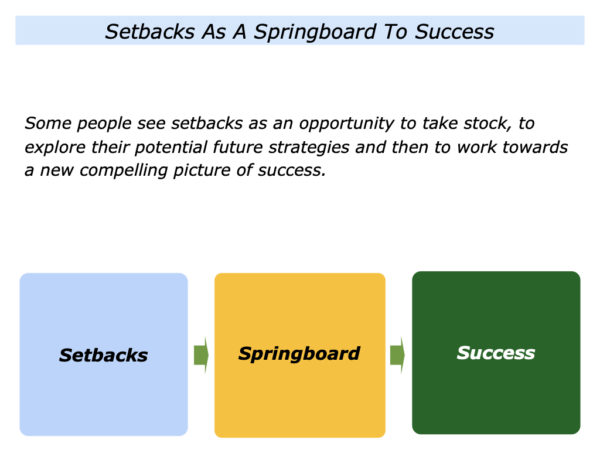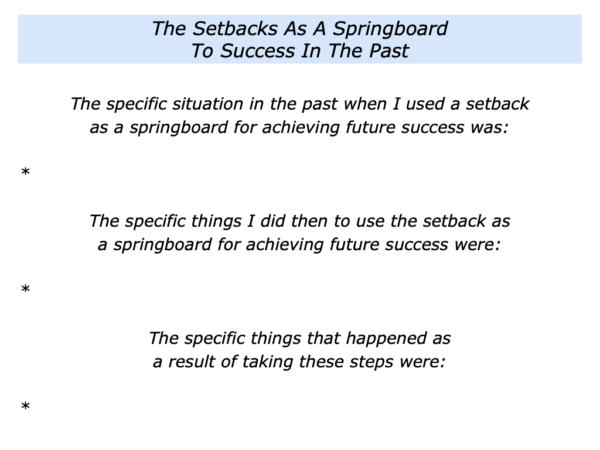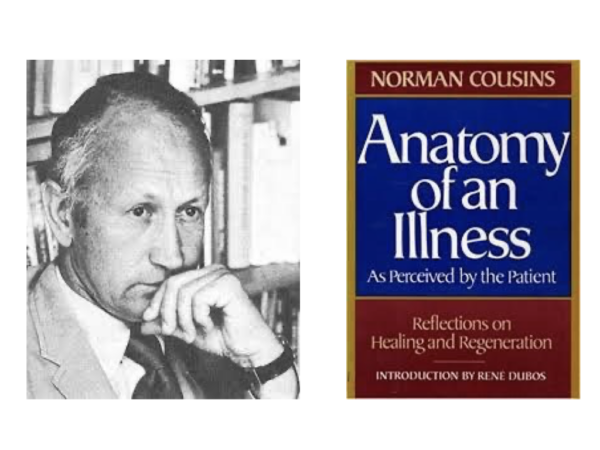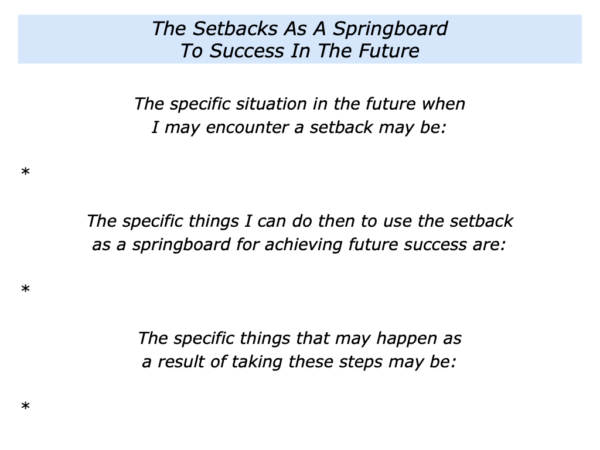
Everybody has both successes and setbacks. Some people build on the successes. They also use the setbacks as a springboard to achieving future success.
Such people deal with the latter part in different ways. Some take the following approach:
They take time to reflect, recover and manage the emotions involved with the setback;
They begin to see the setback as an opportunity to take stock and consider their potential future strategies;
They then use the setback as a springboard towards achieving future success.
A person in the 60s may find their job terminated with little hope of another full-time role. They may reframe this is as an opportunity to provide specialist help to decision makers in their network who want experienced people to do certain projects.
A young football player may be discarded by their club or suffer a career-ending injury. They may reframe this as an opportunity to become a coach or provide advisory services for young players who find their dreams have been dashed.
A person with a harmful addiction may have a traumatic experience. This leads them to making a decision: “Do I want to live longer? Or do I or want to continue with my addictions and die soon?” They may choose to see this an opportunity to live a healthier life.
A couple may try for years to have a child. This becomes emotionally draining and challenging. After a number of years, however, they decide to reframe it as an opportunity to adopt children and provide them with a loving home and family.
A company that hits the rocks may see it as an opportunity to shape a better future. They may return to doing what they do best with the customers with whom they work best. They may then build a company that creates wins for all its stakeholders.
Looking back, can you think of a time when used a setback as a springboard for achieving future success? This could have been in your personal or professional life.
What did you do then to reflect, recover and explore the future opportunities? What did you do to pursue your chosen path? How did you do your best to achieve future success?
If you wish, try tackling the exercise on this theme. This invites you to complete the following sentences.

You will follow your chosen approach to making this happen. If appropriate, however, you may want to pursue some of the following steps in your own way.
You can take time to reflect, recover and
manage the emotions involved with the setback
Different people choose different ways to deal with setbacks. Each approach may have both pluses and minuses. It can be helpful for a person to act in a way that works for them and other people.
Some individuals choose to leap into action. This may be necessary to prevent further problems or shape a better future. Sometimes a person may simply do something that provides a distraction from the pain.
Some individuals use other ways to manage the emotions. They may sleep, talk with friends or go deep into themselves. Some may fall into a downward spiral. Some may begin to recover and gain strength.
Some individuals may feel down. They may recognise, however, that they need to do something to change the feeling. They may therefore do something that they know will give them positive energy.
Some individuals may take time to reflect on the setback. They may aim: a) to clarify what they did well; b) to clarify what they could have done better; c) to clarify the lessons learned and how to apply these in the future.
Imagine that you have gone through some of these steps in your own way. It may then be time to move on to the next stage.
You can begin to see the setback as an opportunity to
take stock and consider your potential future strategies
Different people see the world in different ways. This also influences the way they see and deal with setbacks.
Some individuals are positive but realistic. They prepare, plan ahead and do their best. But they also realise there will be both delights and disappoints.
Such a person may take time to recover from a shock. After a while, however, they may take stock and begin to explore some of the following themes.
What can I do in the future? Are there any ways that I can use this setback as an opportunity? What are my assets? How can I take charge of shaping my future?
Looking ahead, how can I build on my strengths? What are the possible routes I can follow? What may be some of the potential opportunities? How could I pursue these possibilities?
Different people use setbacks in different ways. Some use them to reinforce their view that the world is wrong. Some use them as an opportunity to do their best during their time in the world. Let look at one of the most well-known examples of somebody choosing the second route.
What is the route I want to follow? What would be the pluses and minuses involved? How can I build on the pluses and manage the minuses? On a scale 0-10, how motivated do I feel to do what is required to follow this route?
Looking ahead, what are the real results I want to achieve? What are the key strategies I can follow to give myself the greatest chance of success? When do I want to begin? How can get some early successes?
Imagine that you have gone through some of these steps in your own way. It may then be time to move on to the next stage
You can then use the setback as a springboard
towards achieving future success.
Different people use setbacks in different ways. Some use them to reinforce their view that the world is wrong. Some use them as an opportunity to do their best during their time in the world. Let look at one of the most well-known examples of somebody choosing the second route.

Norman Cousins was born in 1915 and lived till 1990. He was a political journalist, well known for his humanitarian views.
He reached a wider audience, however, with his book Anatomy of an Illness. The book showed how people could mobilise their inner strength to fight illness.
In addition to his journalistic work, Norman was Adjunct Professor of Medical Humanities for the School of Medicine at the University of California. He specialised in researching how human emotions could affect a person’s ability to stay healthy and overcome illness.
Norman translated this into action himself when diagnosed with a life-threatening illness. Told that he had little chance of surviving, Cousins developed a personal recovery programme.
This involved taking lots of Vitamin C, together with mobilising his positive emotions. The latter involved him watching lots of Marx Brothers films. Norman later wrote:
I made the joyous discovery that ten minutes of genuine belly laughter had an anaesthetic effect and would give me at least two hours of pain-free sleep.
When the pain-killing effect of the laughter wore off, we would switch on the motion picture projector again and not infrequently, it would lead to another pain-free interval.
Norman recovered and published his findings in medical journals. This led to him producing the book, whose full title was Anatomy of an Illness as Perceived by the Patient: Reflections on Healing and Regeneration.
Whilst warning against charlatans who ignored real medical problems, Norman stressed the importance of people mobilising their inner resources to live healthy lives. He wrote:
Hearty laughter is a good way to jog internally without having to go outdoors.
Anatomy was published in 1979 and had a profound influence on the way people began conducted themselves as patients. Norman believed that people could take a stand towards setbacks. He wrote:
Wisdom consists of the anticipation of consequences.
A human being fashions his consequences as surely as he fashions his goods or his dwelling his goods or his dwelling. Nothing that he says, thinks or does is without consequences.
Norman was, above everything, a world citizen. He believed that humanity could create a better world. But this would require both imagination and will power. He wrote:
The main failure of education is that it has not prepared people to comprehend matters concerning human destiny.
Leadership on this higher level does not require mountains of gold or thundering propaganda. It is concerned with human destiny. Human destiny is the issue.
The essential lesson most people still resist is that they are members of one species.
It is this that we all share – the emergence of a common destiny and the beginning of the perception, however misty, that something beyond the nation will have to be brought into being if the human race is to have any meaning.
This sounds a big task, but Norman remained a positive realist. Each of us could contribute by encouraging the spark in other human beings. He wrote:
If something comes to life in others because of you, then you have made an approach to immortality.
Let’s return to you own life and work. Looking ahead, can you think of a situation where you may encounter a setback? How could you use it as a springboard towards achieving future success?
If you wish, try tackling the exercise on this theme. This invites you to complete the following sentences.







Leave a Reply